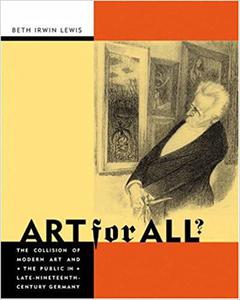
Beth Irwin Lewis, "Art for All?: The Collision of Modern Art and the Public in Late-Nineteenth-Century Germany"
English | ISBN: 0691102643 | 2003 | 448 pages | PDF | 44 MB
This book tells the story of Germany's rich, flourishing, and diversified world of art in the last decades of the nineteenth century-a world that has until recently been eclipsed by the events of the twentieth century. Basing her narrative on a close reading of contemporary periodicals, and lavishly complementing it with cartoons and other illustrations from these publications, Beth Irwin Lewis provides the first systematic, comprehensive study of that German art world. She focuses on how critics and the public responded to new forms of painting that emerged in the 1880s, when the explosive growth of art exhibitions supported by local governments across a recently united Germany was accompanied by skyrocketing attendance of a new mass public.
Describing the rapid critical acceptance and dominance of the new modern art in the 1890s, Lewis analyzes these developments within a complex interweaving of social, cultural, and economic factors. Although critics had hoped for a unified new art for the new nation, the success of modern art fragmented the art world, as modern artists and their supporters turned away from the often unreceptive mass public of the great exhibitions. Lewis's approach through the popular journals reveals the public's growing alienation from modern artists and an increasing contempt for the public on the part of these artists and their supporters-all of which prefigured tensions in the contemporary art world. Her wide-ranging text examines not only the various ways art was promoted to and received by the public, but also anti-Semitism, the role of women artists, and changes in style of both art and criticism.
Well documented, engagingly written, and vividly illustrated, this book will interest not only scholars and students but all readers interested in German cultural history and art history.
Read more


